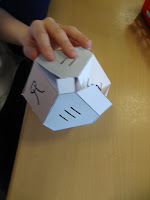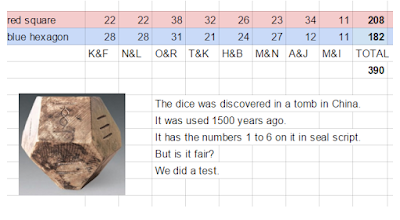Mr Gregg fixed it so that each hexagon and square had exactly the same area, put on the symbols, and added tabs so we could stick it together:
Now we needed to make them:
Once we'd made it, most of us thought it would be a fair dice, but most of us weren't sure!
So today each pair of us rolled one fifty times.
What do you think?
It landed on the red squares a little more than the blue hexagons, but it's very close! Perhaps it's fair...













A&J got much different results than the others. If their data was not included, it looks like the dice are quite fair. SO what is a researcher to do? I suspect that there is something about the way that A&J made their dice that is different from the others, and it would be interesting to see the results if they swapped dice with other students. If the dice that A&J made still comes up with results that are significantly different than the others, well, the question is: who did the truer construction? All the others, or A&J? Lots of good questions to ask here.
ReplyDelete~Paula
Thank you Paula! We'll have a look at that. Also, there are some dice that are really well put together. Maybe we need to test again with those .
ReplyDeleteGood data eye, Paula! And without that one it's 174-170. Did you happen to collect data on how often the whites came up? That should be double the probability of one hexagon.
ReplyDeleteThanks, John. I'm going to have to ask A and J what dice they used. (We ignored the white ones.)
ReplyDelete